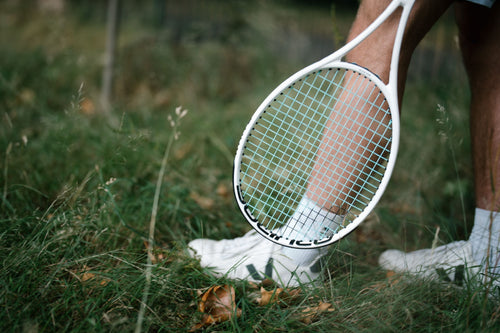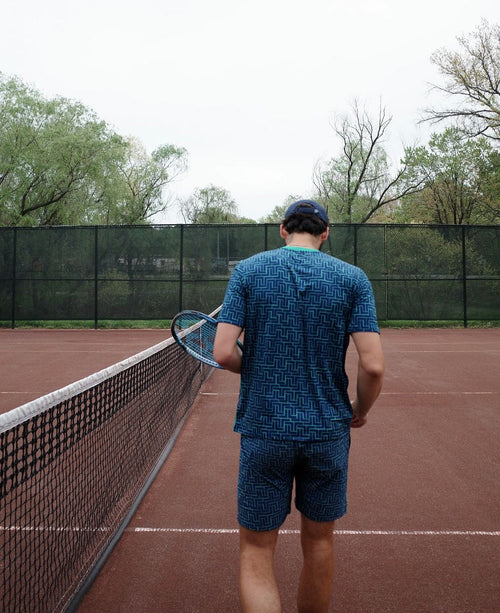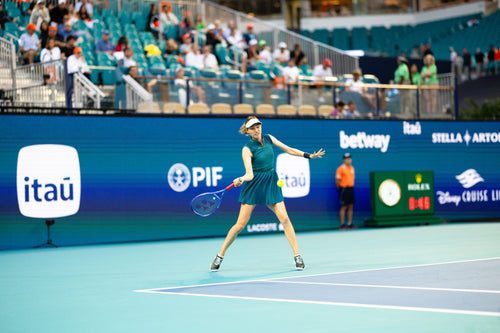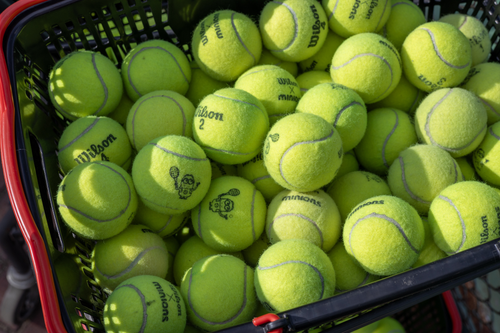The Best Guide to Tennis String Stiffness for Optimal Performance
Juan
Your tennis strings are crucial to your racket’s performance.
They're the only point of contact between you and the ball, so it's no wonder they play the biggest role in how your racket performs.
The stiffness of your strings is one factor that drastically impacts the way the ball feels.
You can think of stiffness as the personality of your string - low stiffness strings (soft strings) will allow your racket to feel plush with often easy access to power while high stiffness strings will make the racket feel more rigid and controlled, which is better for big hitters and high level players.
Understanding Tennis String Stiffness
People measure stiffness by how much a string stretches at impact.
When you hit the ball, your strings flex and deform before snapping back. The amount of deformation is what we mean by stiffness. A stiffer string won’t deform as much while a softer one will deform more.
When you hit the ball, your strings act like a trampoline. The more they stretch (softer strings), the more energy they absorb and transfer back into the ball. The less they stretch (stiffer strings), the less energy they can absorb and the more snappy and controlled they feel.
The Role of String Tension
String stiffness is a very important metric when choosing a string but the tightness with which you string your strings (tension) is also equally as important.
String tension and string stiffness work hand in hand, and together determine how the ball feels in your racket. Even the same string in the same racket can play very differently depending on how tight (or loose) it is strung.
Higher tension = more control and rigidity.
Lower tension = more power and responsiveness.
If you're a beginner, you're probably swinging at the ball at a relatively slow speed. Lower tension (under 53 pounds or so) can give you more power because your strings will stretch more at impact and act more like a trampoline. You can think that a “loose” trampoline will make you jump a bit higher since you have more room to compress and release.
On the other hand, higher tension (over 54 pounds or so) will give you more control but sacrifices responsiveness and comfort. At higher tensions, you’re going to have to put in a little bit more “work” to get the ball moving. Given that a high tension feels more rigid, it’s quite common for players to experience injuries such as tennis elbow when stringing at high tensions so this is a consideration to be aware of.
So how tight do we want to string our strings? What’s the right tension? This will depend on a combination of factors but here are some important considerations to keep in mind:
Choice of string
Is your string soft or stiff? If you have a stiff string, a high tension will make it very control oriented and somewhat unforgiving. In this case, it might be worth stringing lower in tension to get a little bit more responsiveness from this string. If you have a string with low stiffness (soft string) you can afford to string higher in tension which will provide you with more control. Since the string itself is quite comfortable, you won’t need to compensate with stringing lower.
Choice of racket
Are you playing with a stiff racket or a flexible racket? Similar to your string stiffness, the stiffness of your racket will have an impact on how tight you want to string. A stiff racket and a high tension might lead to injury. If you have a flexible frame, you can bring the tension up so you can take bigger cuts at the ball.
Weather
Weather can also significantly influence your tension. Many players string looser in the winter and tighter in the summer since the string bed tends to feel stiff during colder months and tension tends to loosen more quickly during warm weather. If you live at a high altitude, you can also string tighter because the air is thinner and the ball will fly off the string more.
The Benefits and Drawbacks of Stiffer Strings
Benefits
Stiffer strings are perfect for players who like to spin the ball because they provide the most rotation potential.
They're also great for those who like to hit with control because they feel more responsive and precise.
This is why stiff strings are most popular among top players, almost all pros and high level players will have some combination of a stiff string in their racket to get the most out of their powerful games.
Drawbacks
The downside to stiff strings is that they transfer way more shock and vibration to your arm and are much more demanding.
You'll get less free power and have to generate your own with your swing. Stiffer strings are better for players with a faster, more aggressive swing because they can handle the loss of power and appreciate the extra control.
For players with shorter, slower strokes, stiffer strings might feel too demanding. The lack of power assistance makes it hard to hit deep shots, and the increased shock transmission may cause discomfort during extended play. Beginners or recreational players with short swings often opt for softer strings since this is what suits their game the best.
Choosing the Right String Type for Your Game
Poly (or co poly) provides the stiffest response of most strings and is therefore the most widely used type of string on the pro tour.
It's the reason why top players can hit the ball as hard as they do. Without poly, top players wouldn’t be able to control their power and they’d be left swinging for the fences. In a way, the invention of the poly string in the 90s is what also “invented” the modern baseline tennis game.
Poly is a game changer, but it's not for everyone.
If you choose poly, make sure you pick the right type and string it correctly. String it a little lower in tension than you would with other strings and think about how you want it to complement your game and equipment.
There are so many great poly strings to choose from and it’s worth trying a few to see that you like! In need of some extra feel and control, our Sync string is an excellent choice. Looking for some extra power and spin potential, our Zero string will give you just that.
Natural gut is on the opposite end of the spectrum.
It's the most comfortable and powerful string to play with. It's also the most expensive but worth it if you can afford it. The pros still use gut because it’s a great way to soften up a stiff stringbed. Top players won’t string gut on their own but will use it in some combination - usually with a poly to get the best of both worlds.
This method of using two different materials (poly and gut for example) is called hybriding. You can likewise also hybrid with synthetic gut (more affordable and made to mimic gut in certain aspects) or multifilament strings.
Both are great ways to soften up a stiff stringed (via a hybrid with a poly) or equally fine on their own (no hybrid in this case) but recommended more at intermediate and beginner levels.
Injury Prevention and Racquet Stiffness
The relationship between string stiffness and injury prevention is crucial.
Stiffer strings can significantly increase the risk of tennis elbow and other arm injuries, especially when combined with a stiff racquet frame.
Modern racquets have higher stiffness ratings (RA ratings), enhancing power and control but compromising comfort.
Players should consider this when selecting their string setup, as the combination of stiff strings and a stiff frame can increase injury risk.
It is essential to have your racket strung with the right tensions and materials to prevent injuries, especially for different skill levels and physical conditions.
Regular string replacement is also crucial for injury prevention. As strings lose tension and wear out, their performance changes, potentially leading to compensatory technique changes that could increase injury risk.
If you want a softer poly string to reduce your chance of injury, try out our Sync string.
FAQs
What do stiffer tennis strings do?
Stiffer tennis strings feel crisper and respond better to spin, but they're less forgiving and give less power. If you’re a high level player looking to take big cuts at the ball, you’ll likely need a stiff string - poly (or co-poly) is the way to go in this case!
How does string tension affect performance?
String tension impacts racket feel and performance. Higher tension offers more control, while lower tension provides more power. When tweaking tension, you’ll have to think about a few things including the type of string, the stiffness of your racket, weather factors, and ultimately, how you want your string to benefit your game.
Are softer strings better for preventing injuries?
Softer strings are easier on the arm, reducing the risk of injuries like tennis elbow. They absorb more shock and vibrations, making them a better choice for players seeking comfort.
Can string stiffness affect spin potential?
Yes, string stiffness can influence spin potential. Stiffer strings offer more spin due to their ability to snap back quickly after impact, imparting more spin on the ball. If you’re interested in generating serious spin, you’ll likely have to opt for a poly set up which will give you the best spin potential.
























